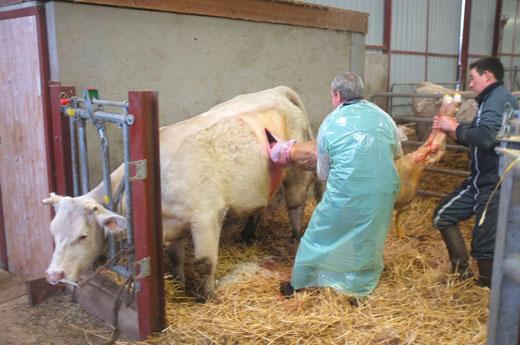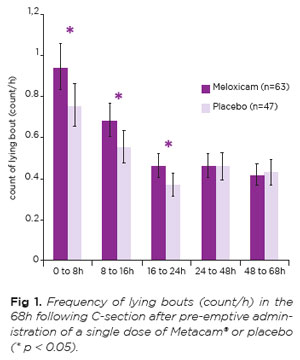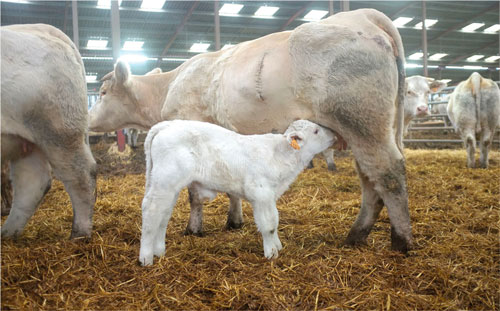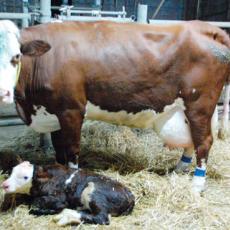
Elke Abbeloos
Dystocia is painful in cows. This is a welfare concern for the animals, but also for consumers who increasingly demand a “humane production” of food.
Pain at calving is also an under- estimated economic factor, since it reduces milk production1, increases the risk of periparturient disease and decreases fertility2. Pain mitigation after calving with non-steroidal anti-inflammatory drugs (NSAIDs) is already widely used by veterinarians worldwide3.
Pain associated with caesarean section (C-section) deserves extra attention. C-section is a common procedure in cattle, usually performed after failure to deliver by manual extraction.
This is most commonly due to a disproportion in size between calf and dam. In some beef breeds, in particular those with the “double muscle gen”, the calf is not even expected to pass through the birth canal. In such cases, routine elective C-sections are performed.
Pain during surgery
During surgery, pain is usually well controlled by local or paravertebral anaesthesia. Sometimes, additional epidural anaesthesia or general sedation are used. These all involve short-lasting products, which means that cows experience postoperative pain due to the cutting of skin, muscle and other tissues. This acute somatic pain is sharp, stinging and highly localised at the site of injury. It appears a few hours after surgery, when the effects of the local anaesthetics wares off. Sensitivity was found to persist up to 14 days after the event3.
In addition, visceral pain is likely to occur due to manipulation and distension of the uterus and other viscera, and the traction needed to extract the foetus. This is followed by tissue inflammation, which is reported in humans as being more diffuse, dull and poorly localised. In non-elective C-sections, there may also be underlying postpartum pain in the reproductive tract.
Even though C-sections are widely performed, only few studies have assessed the pain that cows experience after the operation. One such study involved a herd of the double muscled Belgian Blue breed with a (for that breed) uncommonly large proportion of cows giving birth per vaginam3.

During the study, 13 of the cows delivered “naturally” (unassisted or assisted with traction of up to two people) and 17 underwent C-section after a brief attempt at natural extraction.
Behavioural observation of the cows during the following days showed a significant difference in time budget between the two groups.
The C-section group showed significantly less limb movements and more transitions in posture until 3 days after calving (table 1). The cows of this group rested 60% of the time compared to 30% of the group that calved naturally.
Interpreting lying behaviour
The interpretation of lying behavior in this study was challenging. Not only the intensity of pain may have varied between the two groups of cows, also its localization was different: birth tract compared to abdomen. The expression of lying behavior is quite complex, especially when comparing different conditions.
Lame cows for instance have increased overall lying times, especially due to their lying bouts being longer6. In contrast, cows with clinical mastitis spend more time standing, suggesting discomfort while lying down7.
Kolkman et al. suggested that, in their study, reduced standing and increased lying time should be interpreted as impaired welfare due to increased pain in cows that underwent C-section. Further studies are needed to define whether C-section is indeed more painful than natural delivery. It is likely the outcome will depend upon many factors, including experience of the veterinarian or the amount of traction used for the delivery. Maybe this is of little importance for the cow.
A large study in human medicine has shown that it is not the type of delivery, but the severity of acute pain after birth that predicts long-term negative outcomes such as persistent pain and postpartum depression5.
Impact of analgesics on surgical pain

Severe acute pain associated with parturition can be reduced by analgesics such as NSAIDs. A recent study by Boehringer Ingelheim evaluated the effect of the NSAID Metacam® on pain relief after C-section4. In the study, 110 beef cows, mainly Charolais, underwent non-elective C-sections. They were recruited from eight veterinary practices throughout France.
A few minutes before the first incision, cows received either meloxicam (Metacam®) or a placebo according to a blind randomised schedule. The cows’ activity was monitored from the end of surgery to 72 hours postpartum.
The cows treated with the analgesic spent significantly more time lying down in the hours following the surgery. They also had more transitions in posture during the same time slot.
Again, lying behaviour was used to assess the difference in levels of pain between the two treatment groups. In this case, interpretation was easier as both treatment groups had calved following the same procedure.
The analgesic properties of meloxicam have been proven in many other conditions. It is therefore logical to assume that the increased time spent lying after pre-emptive meloxicam treatment was an indicator of improved resting behaviour and comfort that may result from pain relief.
Conclusion
 C-section is a very common procedure and is associated with pain. However, it is unclear whether C-section in cattle is more or less painful than natural delivery.
C-section is a very common procedure and is associated with pain. However, it is unclear whether C-section in cattle is more or less painful than natural delivery.
When administering an analgesic to cows undergoing C-section, a significant change in lying behaviour was seen. This might indicate increased comfort in the treated animals as the NSAID may alleviate some of the somatic and visceral pain resulting from surgery.
Further research is needed to investigate if NSAIDs may also mitigate some of the risks associated with C-sections, such as increased infertility, increased culling or loss of milk production, all the result of tissue inflammation. Highlighting the economic benefits may help convince farmers to address the need of pain relief in a proactive manner. Cows probably need no convincing.




